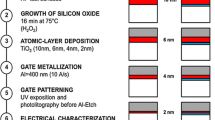Abstract.
We have studied theoretically the capacitance characteristics of a metal–insulator–semiconductor structure with an ultra-thin oxide layer by self-consistently solving Schrödinger and Poisson equations. It is demonstrated that a ‘diffused’ interface between Si and SiO2 results in a better agreement between the theoretical prediction of conduction current and experimental I–V data. The calculated steady-state capacitance, obtained both analytically and numerically, increases following the increase of the gate bias when the gate bias is small; it reaches a saturation value at intermediate gate bias. The capacitance decreases with increasing gate bias when the gate bias is rather large due to the depletion of the gate material. Simple analytical expressions for the gate capacitance are derived, based on quantum-mechanical considerations, for future device design. The steady-state capacitance of a metal–insulator–semiconductor structure with an oxide layer of 1.5–2.0 nm by state-of-the-art technology is 20 mF/m2, while it is 40 mF/m2 when the practical limit of SiO2 layer thickness, i.e. 10–12 Å, is reached.
Similar content being viewed by others
Author information
Authors and Affiliations
Additional information
Received: 25 March 2002 / Accepted: 12 April 2002 / Published online: 10 September 2002
RID="*"
ID="*"Corresponding author. Fax: 46-31/772-2092, E-mail: fyg@fy.chalmers.se
Rights and permissions
About this article
Cite this article
Fu, Y., Willander, M. Capacitance analysis for a metal–insulator– semiconductor structure with an ultra-thin oxide layer . Appl Phys A 76, 27–31 (2003). https://doi.org/10.1007/s00339-002-1472-y
Issue Date:
DOI: https://doi.org/10.1007/s00339-002-1472-y




